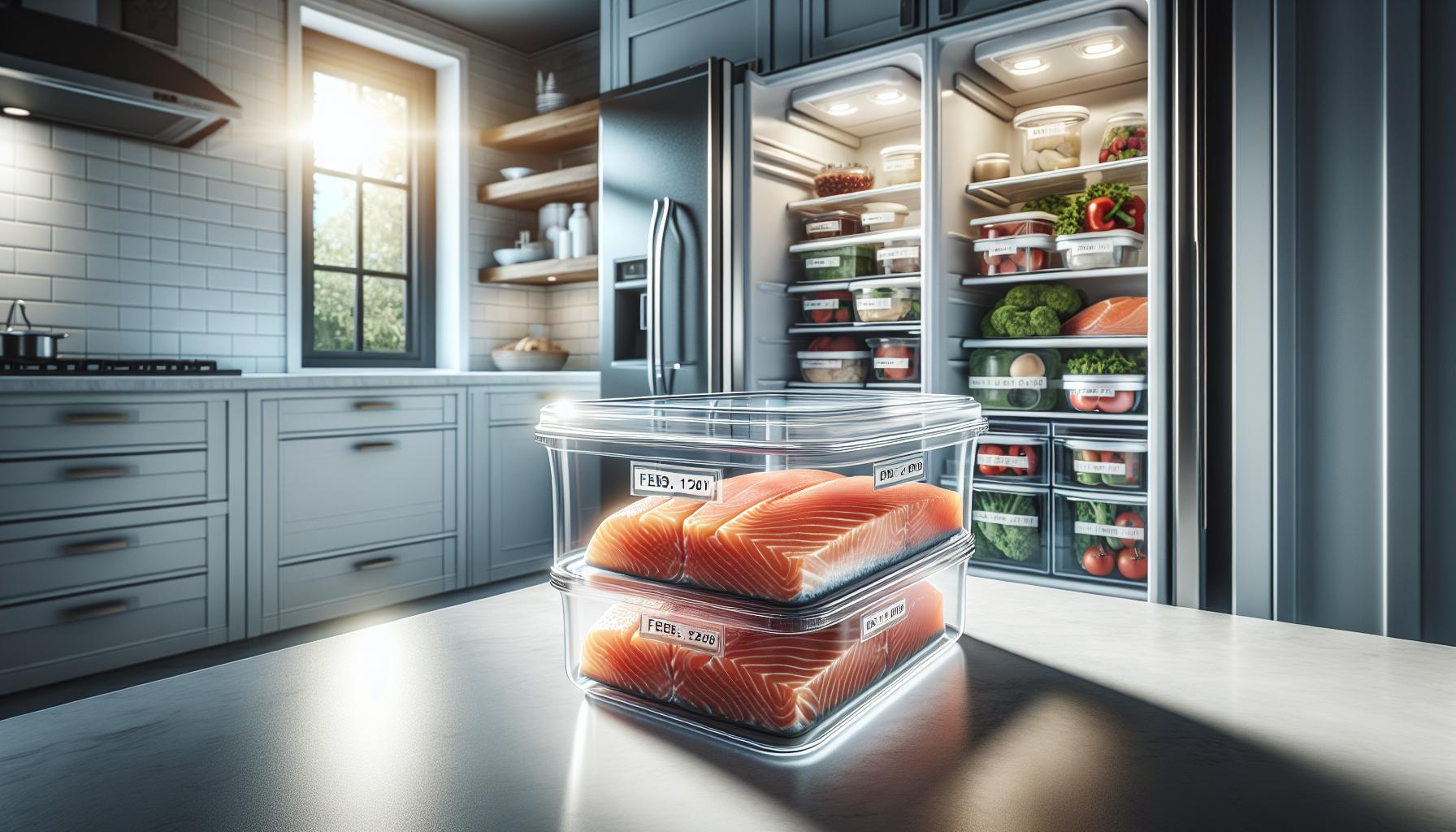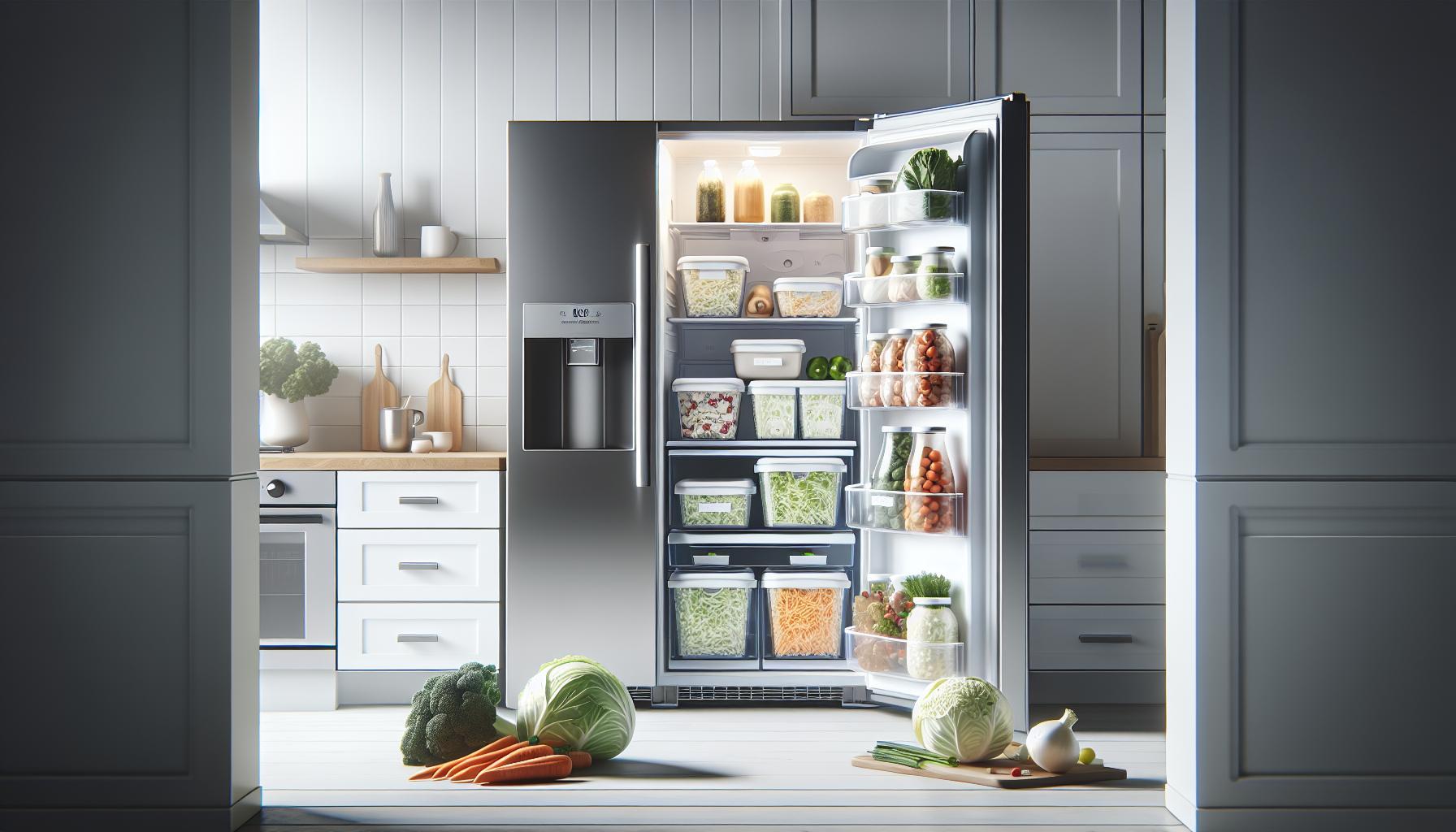Did you know that cooked salmon can last in your fridge for only about three to four days? In today’s fast-paced world, food waste is a concern that many of us face, and knowing how long your leftovers remain safe to eat is essential for both health and budget. Salmon, rich in omega-3 fatty acids and protein, is a valuable addition to your meals, but proper storage is crucial to minimize spoilage.
Understanding the lifespan of cooked salmon in your fridge not only helps prevent waste but also ensures that your meals are safe and delicious. Whether you’re meal prepping or simply enjoying last night’s dinner, knowing the right storage practices can keep your food fresh and your family healthy. In this guide, we’ll explore the best methods for storing cooked salmon and provide you with practical tips to stay on top of food safety, making your kitchen experience both efficient and worry-free. Keep reading to unlock the secrets to maintaining the quality of your favorite seafood dishes!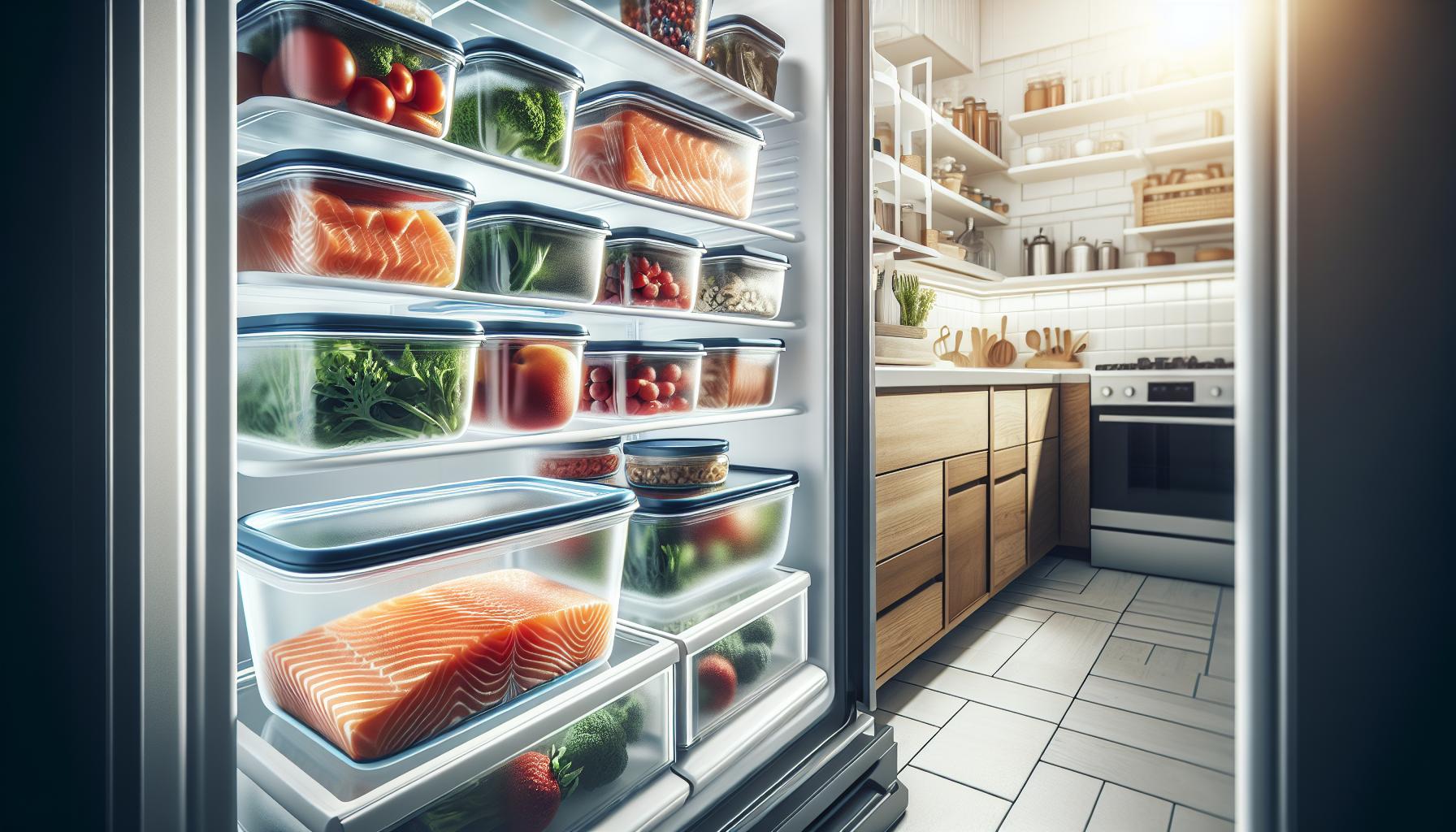
How Long Can You Store Cooked Salmon?
Cooked salmon is not only delicious but also a nutritious option that can be part of many meals. If you find yourself with leftover cooked salmon, understanding how long you can store it is crucial for maintaining freshness and ensuring food safety. Generally, cooked salmon can be stored in the refrigerator for up to 3 to 4 days. This time frame allows you to enjoy your leftovers without compromising quality or safety.
To maximize the shelf life of cooked salmon, it’s important to store it properly. Place the salmon in an airtight container or tightly wrap it in aluminum foil or plastic wrap to prevent exposure to air, which can lead to spoilage. Keeping your refrigerator at or below 40°F (4°C) will help slow bacterial growth, further enhancing the safety of your leftovers. If you want to keep it longer, consider freezing the cooked salmon, which can extend its shelf life to 2 to 3 months without significant loss of quality.
Be sure to label the container with the date it was cooked to keep track of how long it has been stored. This simple practice can help you avoid potential food waste and ensure that you always consume your leftovers at their best. Following these guidelines will allow you to enjoy your cooked salmon while minimizing health risks and preserving flavor.
Signs Cooked Salmon Has Gone Bad
Recognizing when cooked salmon has gone bad is crucial for both safety and taste. Consuming spoiled fish can lead to foodborne illnesses, so being informed helps you make safe choices. One of the most immediate indicators of spoilage is the change in smell. Freshly cooked salmon has a mild, pleasant aroma, but if you detect a sour, ammonia-like, or overly fishy odor, it’s time to discard it.
Another sign to watch for is the texture. Cooked salmon should be moist and flaky. If it feels excessively slimy or sticky, this is a clear indication of spoilage. Discoloration can also be a telltale sign; ideally, cooked salmon should maintain a pinkish hue. If you notice gray or dull patches, it’s best to err on the side of caution and throw it away.
Additionally, checking the storage time is essential. If your cooked salmon has been sitting in the refrigerator for more than 3 to 4 days, it poses a higher risk of spoiling, regardless of the other signs. Always prioritize food safety and don’t hesitate to dispose of any product that raises doubt about its freshness. By staying vigilant and informed, you can enjoy your salmon leftovers while avoiding unpleasant and potentially dangerous situations.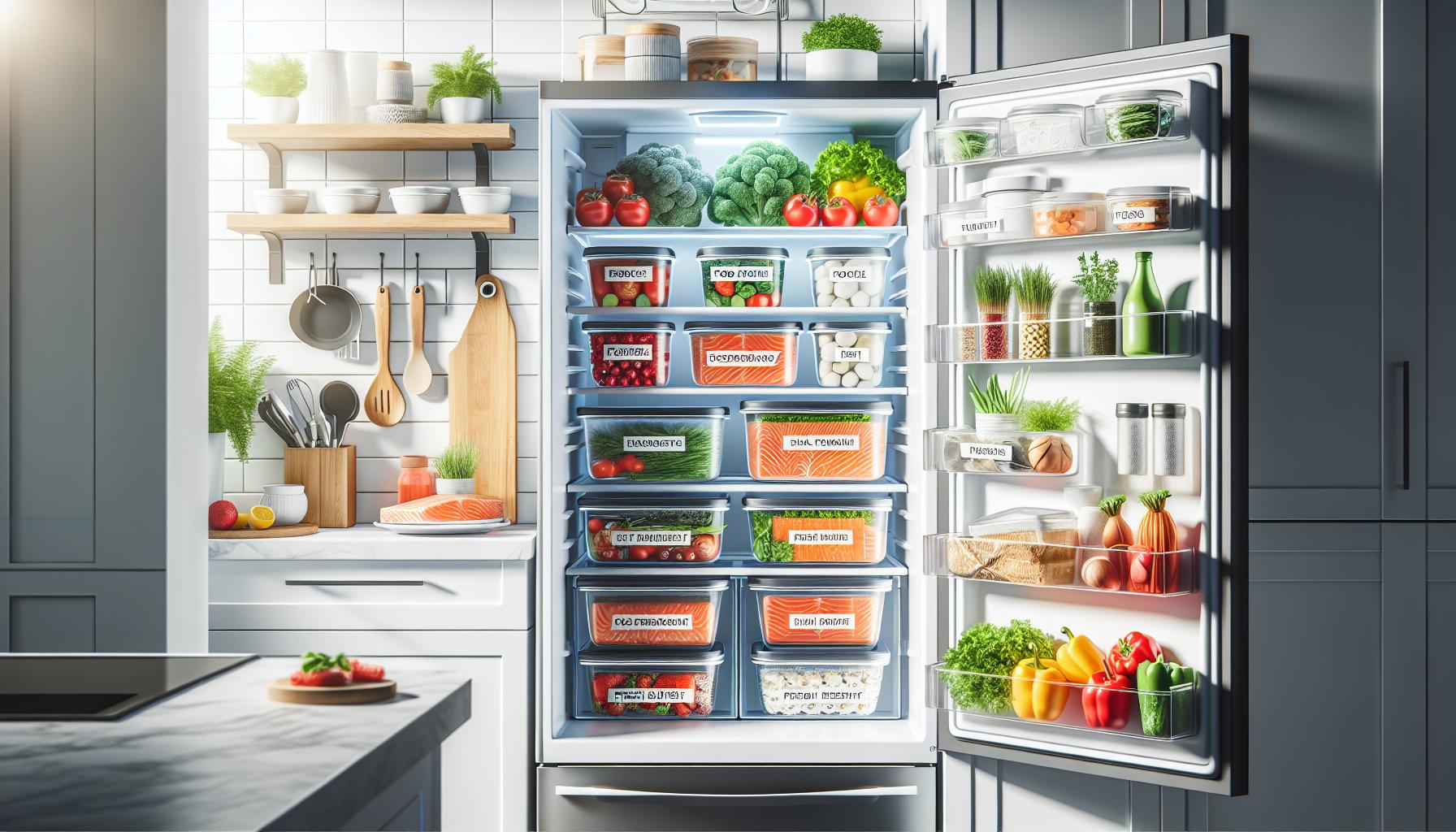
Best Practices for Storing Cooked Salmon
Storing cooked salmon correctly is essential not only for preserving its taste but also for ensuring food safety. When you’ve cooked a delicious salmon dish, knowing how to store it properly can extend its shelf life and help avoid waste. One key to successful storage is immediate cooling. After cooking, let the salmon cool down to room temperature for no more than two hours before transferring it to the refrigerator. This helps inhibit bacterial growth.
For optimal preservation, ensure that the cooked salmon is stored in airtight containers. This prevents exposure to air, which can cause it to dry out and lose flavor. Additionally, using clear, labeled containers can help you easily track how long it has been stored. It’s advisable to consume cooked salmon within 3 to 4 days if kept in the refrigerator; any longer can elevate the risk of spoilage. Keep your fridge at or below 40°F (4°C) to maintain food safety.
Freezing for Longer Storage
If you won’t be able to finish the cooked salmon within a few days, freezing it is a smart option. Properly wrapped, cooked salmon can last for up to 6 months in the freezer. Be sure to double wrap the salmon in plastic wrap and aluminum foil or place it in freezer bags to prevent freezer burn. When you’re ready to eat it, thaw the salmon in the refrigerator for the best results, rather than at room temperature, to minimize the risk of bacteria.
Utilizing these best practices not only extends the life of your cooked salmon but also supports a sustainable approach to food consumption. By being proactive about storage, you can safeguard both your health and your culinary enjoyment.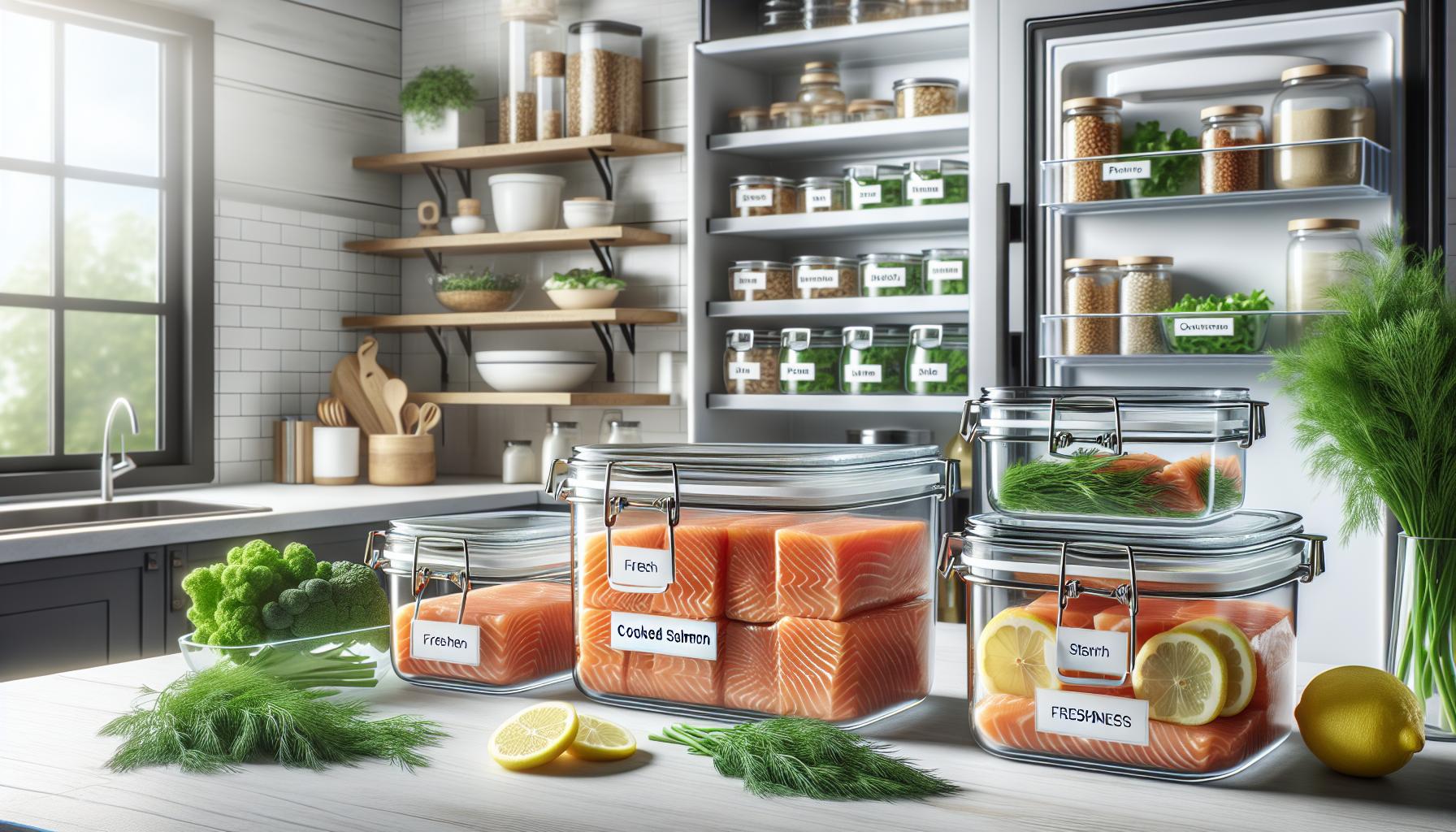
How to Reheat Cooked Salmon Safely
To enjoy your leftover cooked salmon safely and keep it tasting delicious, reheating it properly is essential. Many people underestimate the risk of foodborne illness when reheating seafood, but following safe practices can ensure your meal remains both enjoyable and safe. One important tip is to always reheat your salmon to an internal temperature of 145°F (63°C). This temperature is effective in eliminating any harmful bacteria that may have developed during storage.
There are several methods you can use to reheat cooked salmon. The oven is one of the best for retaining moisture and texture. Preheat your oven to 325°F (163°C) and place the salmon in an oven-safe dish, adding a splash of water or broth and covering it with foil. This will help keep the salmon moist while it warms. Heat it for about 15 to 20 minutes, checking the internal temperature to ensure it reaches the safe level.
Another convenient method is using a microwave. Place the salmon on a microwave-safe plate, cover it with a damp paper towel to retain moisture, and heat it on medium power in short bursts of 30 seconds, checking the temperature regularly. Be cautious to avoid overheating, as it can quickly become dry and unappetizing.
For a quick option, pan-searing on the stovetop is effective, especially if you prefer a crispy exterior. Heat a small amount of oil in a skillet over medium heat, add the salmon, and cover to heat through until it reaches the desired temperature. This method not only warms it up but also revives some of that flaky texture.
Regardless of the reheating method you choose, always strive for even heating. Consider cutting larger portions into smaller pieces to facilitate quicker and more uniform reheating. Doing so not only enhances safety but also allows for better texture and flavor retention. By taking these steps, you can enjoy your leftover salmon while ensuring it’s safe to eat.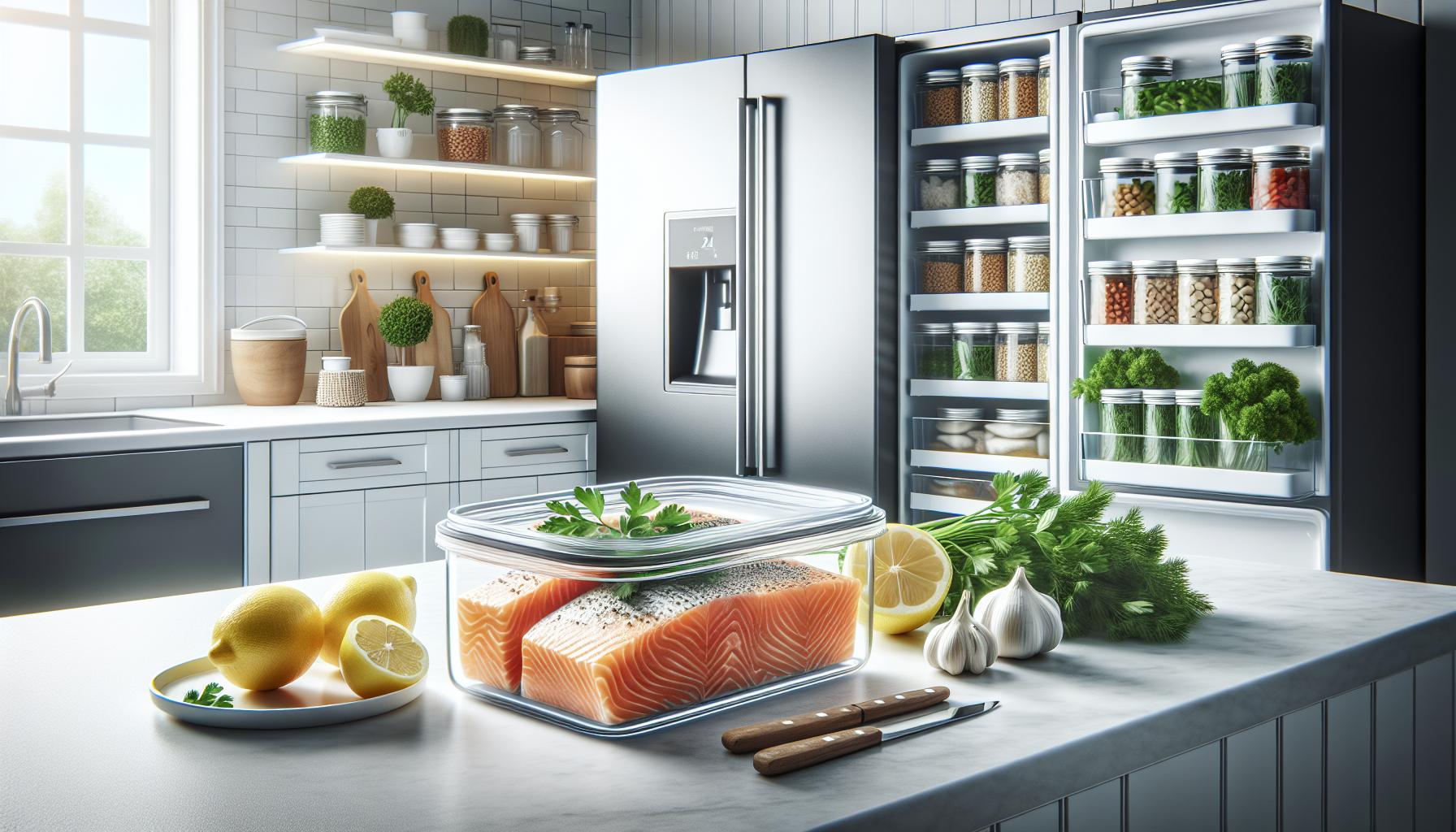
Freezing Cooked Salmon: A Complete Guide
Freezing cooked salmon is an excellent way to extend its shelf life and reduce food waste, allowing you to enjoy this nutritious fish even weeks after cooking. When handled and stored correctly, frozen cooked salmon can maintain its quality for up to three months. The key lies in the proper freezing techniques that preserve the flavor and texture while ensuring safety.
To freeze cooked salmon effectively, start by letting it cool to room temperature. Once cooled, wrap individual portions tightly in plastic wrap, ensuring no air can escape. Follow this by placing the wrapped portions in airtight freezer bags or containers. Remove as much air as possible before sealing to prevent freezer burn. Label the packaging with the date to help track its storage time, thereby ensuring you use it within the recommended timeframe.
For best results, consider the condition of the salmon before freezing. If the salmon has been cooked with sauces or toppings, it may freeze well. However, plain salmon or salmon with delicate sauces tends to fare better when frozen without complicated additions, as these can alter the texture once thawed. Remember to freeze the salmon in meal-sized portions; this not only makes thawing more manageable but also minimizes waste, as you can defrost only what you plan to eat.
When it comes time to enjoy your frozen salmon, the safest method to thaw it is in the refrigerator overnight. This gradual thawing not only maintains quality but is also crucial for food safety, preventing the growth of harmful bacteria. For a quicker option, you can use the defrost setting in a microwave, but be sure to consume it immediately thereafter, as parts of the salmon might start cooking in the process. Properly freezing and thawing cooked salmon enables you to savor its rich flavor while keeping safety at the forefront of your meal prep.
Tips to Maximize Salmon Freshness
To ensure that your cooked salmon stays fresh for as long as possible, proper storage and handling techniques are essential. Cooked salmon can typically last in the refrigerator for up to three to four days when stored correctly. Begin with the right cooling method; let the salmon cool to room temperature before placing it in the fridge to avoid raising the internal temperature of the fridge, which can promote bacterial growth.
When storing, keep the cooked salmon in an airtight container or tightly wrap it with aluminum foil or plastic wrap. This helps to prevent exposure to air, which can lead to oxidation and spoilage. Additionally, placing a paper towel in the container can absorb excess moisture, helping to maintain the texture and taste.
Regularly check your fridge’s temperature setting; it should be kept at or below 40°F (4°C) to ensure food safety. Keep your cooked salmon toward the back of the fridge, where the temperature is usually more stable. If you know you won’t eat the salmon within a few days, consider freezing it as mentioned earlier. Properly prepared cooked salmon can retain its best quality in the freezer for up to three months.
To extend the freshness further, be mindful of the type of seasoning or sauces used on your salmon. Ingredients like acidic marinades or spices can affect the flavor, so consider plain cooking or light seasoning to keep its taste vibrant when reheated. Adapting these practices not only enhances the longevity of your salmon but also ensures that every bite is as delicious as the first.
Serving Ideas for Leftover Cooked Salmon
Leftover cooked salmon can be a flavorful and versatile ingredient that enhances various dishes, preventing waste while adding nutritional value. With its rich taste and health benefits, it’s easy to incorporate leftover salmon into a variety of meals. Whether you’re looking for a quick lunch or an impressive dinner, here are some creative serving ideas.
One popular use for leftover salmon is to create delectable salmon salads. Flake the salmon and toss it with mixed greens, cherry tomatoes, cucumbers, and a light vinaigrette for a refreshing dish. For a heartier option, consider a creamy salmon salad with mayonnaise, diced celery, and capers served on whole-grain bread or as a filling for a wrap.
Another fantastic option is to add cooked salmon to pasta dishes. Mix flaked salmon with your choice of pasta, olive oil, garlic, and fresh herbs like dill or basil. This can create a quick weeknight meal that is both satisfying and nutritious. Additionally, incorporating salmon into a frittata or omelet with vegetables and cheese provides a wholesome breakfast or brunch idea that makes use of leftover fish.
You can also try crafting a flavorful salmon chowder. Combine the flaked salmon with potatoes, corn, and a creamy broth for a warm and comforting soup. This method not only brings new life to the leftovers but also offers a delicious way to keep warm during colder months.
By incorporating these ideas, you can enjoy the deliciousness of cooked salmon without worrying about it going to waste. These meals are not only satisfying but also exceedingly easy to prepare, allowing you to maximize your leftovers while keeping food safety in mind. Remember to refrigerate any uneaten dishes promptly and consume them within three to four days for the best flavor and safety.
Food Safety Guidelines for Fish Storage
Ensuring the safety of your cooked salmon is paramount, as improper storage can lead to foodborne illnesses. Cooked salmon can typically be kept safely in the refrigerator for up to three to four days when stored properly. To maximize safety and freshness, it is essential to cool the salmon quickly after cooking and store it airtight. This minimizes exposure to bacteria and helps maintain its quality.
When storing cooked salmon, follow these guidelines for optimal food safety:
- Cool Promptly: Refrigerate cooked salmon within two hours of cooking. If the ambient temperature is above 90°F (32°C), refrigerate within one hour.
- Airtight Storage: Place the salmon in shallow airtight containers or wrap it tightly with plastic wrap or aluminum foil. This prevents oxygen from promoting spoilage.
- Label and Date: Always label your containers with the date to keep track of how long the salmon has been stored.
- Check Temperature: Ensure your refrigerator is set to 40°F (4°C) or lower to inhibit bacterial growth.
If you’re unsure about the salmon’s freshness, observe for signs of spoilage such as an off smell, a dull appearance, or a slimy texture. When in doubt, it’s better to err on the side of caution and dispose of the fish rather than risk foodborne illness.
By following these food safety guidelines, you can enjoy your cooked salmon worry-free, maximizing its deliciousness while minimizing waste. It’s essential to stay vigilant about food storage practices to ensure both safety and quality in your meals.
Understanding Food Spoilage and Safety Risks
Understanding the factors that contribute to food spoilage is crucial for keeping your meals safe and enjoyable. Cooked salmon, while delicious, can become a breeding ground for bacteria if not handled and stored properly. One important fact to remember is that harmful bacteria, such as Listeria and Salmonella, can thrive even at refrigeration temperatures, albeit at a slower rate. This means that proper storage practices are vital to prevent these microbes from making you ill.
The main culprits of spoilage are temperature fluctuations and extended exposure to air. After cooking salmon, it should be refrigerated promptly-ideally within two hours, or one hour if the temperature is above 90°F (32°C). When cooked salmon cools slowly, it can enter the “danger zone” (40°F to 140°F or 4°C to 60°C) where bacteria grow rapidly. Storing salmon in airtight containers minimizes oxygen exposure, significantly reducing the risk of spoilage. Moreover, check your refrigerator’s temperature settings to ensure they maintain an environment conducive to safe food storage.
It’s also essential to recognize the signs of spoilage-visually inspect the salmon for a dull color, check for a sticky or slimy texture, and trust your nose; any off or sour smell indicates deterioration. It’s not just about using your senses; labeling and dating your stored food helps you keep track of its freshness. Following the guideline that cooked salmon should be consumed within three to four days allows you to enjoy your meals without risking foodborne illnesses. Prioritizing these practices ensures that your salmon remains delightful and safe to eat, so you can savor your culinary creations without unnecessary worry.
Common Mistakes When Storing Cooked Salmon
Storing cooked salmon incorrectly can lead to wasted food and potential health risks. One of the most common mistakes is not refrigerating the salmon promptly after cooking. To maintain freshness and safety, it’s crucial to refrigerate cooked salmon within two hours of preparation-one hour if the room temperature exceeds 90°F (32°C). Allowing salmon to sit out longer creates an opportunity for bacteria to grow rapidly, especially if the food enters the danger zone of 40°F to 140°F (4°C to 60°C).
Another frequent error is using improper storage containers. Many people opt for plastic wrap or aluminum foil, which can expose the salmon to air and lead to spoilage. Instead, choose airtight containers that completely seal out oxygen. This reduces the risk of oxidation and preserves the salmon’s quality. Additionally, labeling the containers with the date of storage can help you keep track of how long the salmon has been stored, allowing for better management of your leftovers.
Additionally, contrary to common belief, freezing cooked salmon as a long-term storage solution can lead to texture and flavor degradation if not done correctly. The key is to freeze the salmon as soon as it’s cooled down and before it’s stored in the fridge for extended periods. Using freezer-safe, airtight bags or containers not only saves space but also minimizes exposure to air, preventing freezer burn that can compromise the flavor and quality.
Finally, many overlook checking their refrigerator’s temperature settings. Ensuring your fridge maintains a temperature below 40°F (4°C) is essential for food safety. Regularly verify that your fridge is working efficiently; a malfunction can lead to elevated temperatures, increasing the risk of spoilage. By avoiding these common mistakes, you can enjoy your cooked salmon safely and reduce food waste.
Creative Recipes for Leftover Salmon
Leftover cooked salmon can be a culinary treasure when transformed into delightful new dishes, allowing you to maximize its use while preventing waste. With proper storage, cooked salmon remains safe in the refrigerator for up to three to four days, and with these creative recipes, you can enjoy it in varied forms instead of eating the same meal repeatedly.
One tempting option is to make a salmon salad. Flake the leftover salmon and mix it with Greek yogurt, Dijon mustard, diced celery, and a squeeze of lemon juice. This light, creamy salad can be served on toast, in a sandwich, or atop a bed of fresh greens for a nutritious lunch. Alternatively, consider preparing salmon cakes by combining flaked salmon with breadcrumbs, an egg, finely chopped onions, and seasonings of your choice. Form patties and pan-fry them until golden brown. These can be enjoyed on their own, in a bun, or with a dipping sauce.
For a comforting dish, try a salmon and vegetable stir-fry. Heat some olive oil in a pan, add an assortment of seasonal vegetables like bell peppers and broccoli, and toss in your leftover salmon towards the end just to heat it through. Serve this stir-fry over rice or quinoa for a complete meal. If you’re looking for something a bit more adventurous, why not whip up salmon tacos? Use warmed corn tortillas, add the flaked salmon, and top with avocado, fresh salsa, and a drizzle of lime crema for a fresh and vibrant dinner option.
To round out your creations, consider incorporating leftovers into breakfast. Create a salmon omelet by mixing flaked salmon with eggs, cream cheese, and chives, resulting in a satisfying start to your day. Each recipe provides a new twist on cooked salmon, making it easy to enjoy your leftovers without sacrificing variety, while also aligning with food safety practices and extending the shelf life of your meal prep.
FAQ
Q: How can I tell if cooked salmon is still safe to eat?
A: To determine if cooked salmon is safe to eat, check for off smells, a slimy texture, or discoloration. If it smells sour or rancid, or if there’s any sign of mold, it’s best to discard it. For detailed guidance, refer to the section on “Signs Cooked Salmon Has Gone Bad.”
Q: What should I do if I accidentally eat expired cooked salmon?
A: If you accidentally consume expired cooked salmon, monitor yourself for symptoms such as nausea, vomiting, or diarrhea. If symptoms occur, stay hydrated and consult a healthcare professional if they worsen or don’t improve. For safety tips, see our “Food Safety Guidelines for Fish Storage.”
Q: Is it safe to reheat cooked salmon multiple times?
A: Generally, reheating cooked salmon multiple times is not recommended due to the risk of bacteria growth. If you need to reheat, do so only once and ensure it’s heated thoroughly to an internal temperature of 165°F (74°C). Refer to “How to Reheat Cooked Salmon Safely” for more info.
Q: Can I store cooked salmon in a vacuum-sealed bag?
A: Yes, storing cooked salmon in a vacuum-sealed bag can extend its freshness. It helps prevent exposure to air and moisture, allowing it to last up to 2 weeks in the fridge. Check the “Best Practices for Storing Cooked Salmon” for optimal storage tips.
Q: What are the risks of eating stale cooked salmon?
A: Eating stale cooked salmon can expose you to foodborne illnesses caused by bacteria such as Salmonella or Listeria. Consuming spoiled fish may lead to symptoms like gastrointestinal distress. Always follow safe storage practices as outlined in “Understanding Food Spoilage and Safety Risks.”
Q: How long can cooked salmon be left out at room temperature?
A: Cooked salmon should not be left out at room temperature for more than 2 hours. After that, bacteria can grow rapidly, increasing the risk of foodborne illness. For tips on safe storage times, refer to our article section “Food Safety Guidelines for Fish Storage.”
Q: Can cooked salmon be frozen after it has been cooked?
A: Yes, cooked salmon can be frozen for up to 6 months. Be sure to wrap it tightly in plastic wrap or foil and place it in an airtight container to prevent freezer burn. Check our “Freezing Cooked Salmon: A Complete Guide” for detailed instructions.
Q: How long does cooked salmon last in the fridge once opened?
A: Once opened, cooked salmon should be consumed within 3-4 days for optimal safety and quality. Ensure it is stored in an airtight container in the refrigerator. You can find more about storage times in “How Long Can You Store Cooked Salmon?”
To Wrap It Up
To ensure your cooked salmon stays fresh and safe, remember it lasts up to three to four days in the fridge when stored properly. Don’t let leftovers go to waste-toss them in a salad or pasta the next day! If you’re uncertain, always check for signs of spoilage. For more tips on food safety, explore our articles on “The Best Ways to Store Fish” and “How to Tell if Salmon is Bad.”
Ready to dive deeper into your culinary journey? Subscribe to our newsletter for expert tips and recipes that keep your meals delicious and safe. Don’t hesitate to share your thoughts in the comments or ask questions! Your feedback helps us grow and improve. Keep exploring our site for more informative content and to maximize your cooking adventures!


